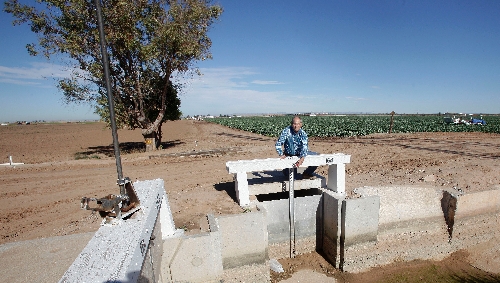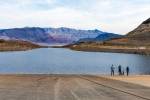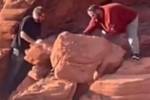California water wars focus on Salton Sea, Colorado River pact
HOLTVILLE, Calif.
The evaporating Salton Sea is the flashpoint for the latest dispute in California's water wars, testing an uneasy alliance of farmers and city dwellers to wean the state from reliance on Colorado River water.
California officials agreed in 2003 to stop taking more than its share from the Colorado, ensuring that Arizona and Nevada don't get shortchanged. The plan's centerpiece called for shifting enough water from the agricultural Imperial Valley to serve nearly 600,000 San Diego area homes.
The huge farm-to-city water transfer threatened California's largest lake . More than 200 feet below sea level, the Salton Sea survives on water that seeps through the soil of Imperial Valley farms.
For seven years, the solution has been to pump enough water into the Salton Sea to offset what was lost to San Diego. The 350-square-mile lake is evaporating at a rate of roughly 450 million gallons a year, but the thinking was to prevent the San Diego transfer from hastening its demise.
All went as planned until a judge ruled early last year that the 2003 pact was invalid, finding the state of California violated its Constitution by essentially writing a blank check to protect the lake as part of the agreement. The pact remains in effect while the ruling is appealed.
The judge's ruling created a rift between two major water players in California: the Imperial Irrigation District and the Metropolitan Water District of Southern California, the water giant that reaches 19 million consumers.
Imperial Valley farmer Ralph Strahm, who owns 4,700 acres in Holtville, south of the Salton Sea, believes too much is at stake to risk returning to decades of acrimony that preceded the 2003 accord .
That pact required the Imperial Irrigation District to put a gallon of water in the lake for every two it reassigned to San Diego, giving the state time to work out a long-term lake rescue plan by 2017. It also agreed to pay farmers to idle some land so the diversion would be possible.
Farmers have received $40.1 million to idle land since 2003, roughly $350 an acre covering 16,700 of the region's 450,000 acres.
Imperial officials began to have second thoughts about signing contracts for the 2011-12 season after the judge invalidated the pact. If the ruling stands, they wouldn't be able to sell water to San Diego and would be stuck with the contracts. Farmers are getting $6.9 million this season.
General Manager Brian Brady placed an order with the U.S. Bureau of Reclamation in September for enough Colorado River water to supply 82,500 homes and sent it to the Salton Sea. He said the water was being stored there while the pact was in legal limbo.
Metropolitan Water District officials cried foul, saying Brady diverted water to which they were entitled under a pecking order established in 1931 among California agencies. As a result, officials at the Los Angeles-based agency said they might be forced to draw water from Nevada's Lake Mead . Managers at the Southern Nevada Water Authority accused Imperial officials of being shortsighted.
Meanwhile, Imperial officials have accepted bids to idle land in 2011-12 but warned farmers they may not award contracts.
Wayne Olesh, 59, volunteered to idle about 200 of his 1,000 acres near Holtville. In the past, the payments have given him enough comfort to gamble on riskier crops such as alfalfa, which can get wiped out by heavy rains.
"It gives me a guaranteed amount I can count on. It's sort of like insurance."
Critics say idled land is a drag on an economy that needs help. Imperial County had a 29.1 percent unemployment rate late last year.
Alfalfa grower Tom Brundy, 54, says farmers aren't hiring laborers, repairing equipment or buying fertilizer.
"I'm a farmer, and a farmer farms," he says.
Amid the squabbling, the Salton Sea's elevation is dropping up to 12 inches a year, exposing about 800 acres a year and turning shallow waters into dry beds . A vast area outside Calipatria that was covered with water a few years ago looks like white moonscape with a few gangly trees.
Its waters, about one-third saltier than the ocean, continue to draw pelicans and a variety of birds that feed on tilapia, desert pupfish and sailfin mollies. But biologists say they will disappear without fish to prey upon.
The lake formed in 1905 when a Colorado River levee breached. In the 1950s and 1960s, it was a major tourist draw and desert playground for celebrities such as Frank Sinatra, Jerry Lewis, Bing Crosby and the Beach Boys.
With a budget crisis that threatens schools and health clinics, California isn't close to financing a long-term plan to save it. Former Gov. Arnold Schwarzenegger's administration offered a plan that would cost $9 billion.
In foreclosure-ravaged Salton City, a town of about 1,000 people where homes sell for as little $20,000, residents marvel at how fast the water is receding.
Jean Cloyd, 76, who retired from Reno in 1995 with her husband, saw fishermen daily from her beachfront mobile home three years ago but now hardly ever does.
"From here it looks like sand but you walk out there and it's all dead fish bones."




























